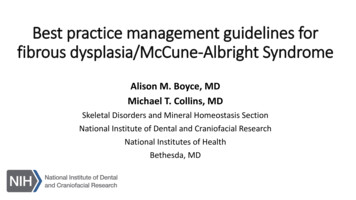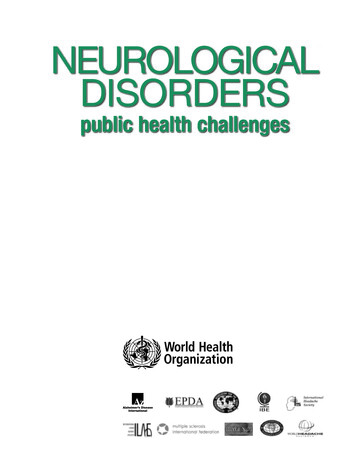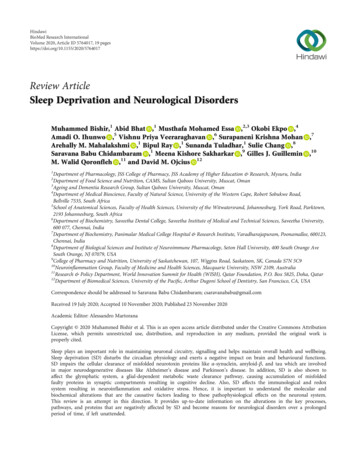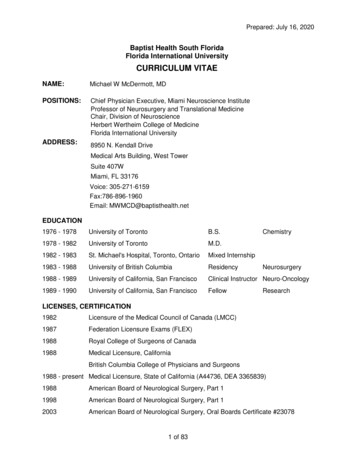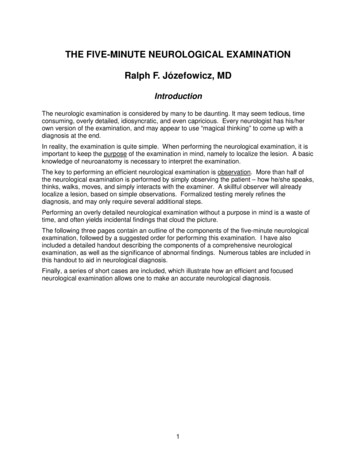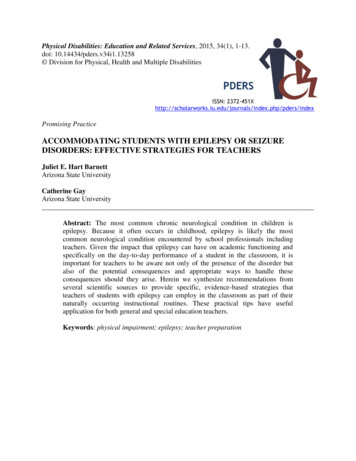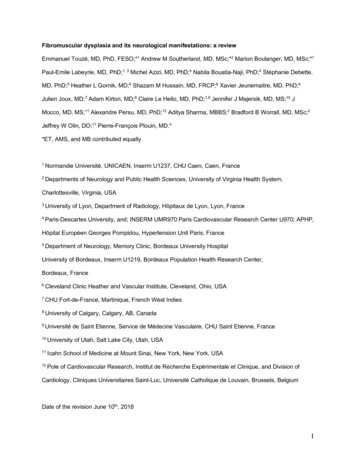
Transcription
Fibromuscular dysplasia and its neurological manifestations: a reviewEmmanuel Touzé, MD, PhD, FESO;*1 Andrew M Southerland, MD, MSc;*2 Marion Boulanger, MD, MSc;*1Paul-Emile Labeyrie, MD, PhD;1, 3 Michel Azizi, MD, PhD;4 Nabila Bouatia-Naji, PhD;4 Stéphanie Debette,MD, PhD;5 Heather L Gornik, MD;6 Shazam M Hussain, MD, FRCP;6 Xavier Jeunemaitre, MD, PhD;4Julien Joux, MD;7 Adam Kirton, MD;8 Claire Le Hello, MD, PhD;1,9 Jennifer J Majersik, MD, MS;10 JMocco, MD, MS;11 Alexandre Persu, MD, PhD;12 Aditya Sharma, MBBS;2 Bradford B Worrall, MD, MSc;2Jeffrey W Olin, DO;11 Pierre-François Plouin, MD.4*ET, AMS, and MB contributed equally1Normandie Université, UNICAEN, Inserm U1237, CHU Caen, Caen, France2Departments of Neurology and Public Health Sciences, University of Virginia Health System,Charlottesville, Virginia, USA3University of Lyon, Department of Radiology, Hôpitaux de Lyon, Lyon, France4Paris-Descartes University, and; INSERM UMR970 Paris Cardiovascular Research Center U970; APHP,Hôpital Européen Georges Pompidou, Hypertension Unit Paris, France5Department of Neurology, Memory Clinic, Bordeaux University HospitalUniversity of Bordeaux, Inserm U1219, Bordeaux Population Health Research Center,Bordeaux, France6Cleveland Clinic Heather and Vascular Institute, Cleveland, Ohio, USA7CHU Fort-de-France, Martinique, French West Indies8University of Calgary, Calgary, AB, Canada9Université de Saint Etienne, Service de Médecine Vasculaire, CHU Saint Etienne, France10University of Utah, Salt Lake City, Utah, USA11Icahn School of Medicine at Mount Sinai, New York, New York, USA12Pole of Cardiovascular Research, Institut de Recherche Expérimentale et Clinique, and Division ofCardiology, Cliniques Universitaires Saint-Luc, Université Catholique de Louvain, Brussels, BelgiumDate of the revision June 10th, 20181
Correspondance to: Emmanuel Touzé, Normandie Univ, UNICAEN, Inserm U1237, CHU Caen, Caen,France (14000) emmanuel.touze@unicaen.frWord count abstract: 350 – Word count paper: 3499References: 67 – Table: 1, Figures: 42
DisclosuresDr Touzé is assistant editor for Stroke journal (AHA)Dr Southerland is section editor for the Neurology Podcast, was a consultant for the National StrokeAssociation, and has received research support from the American Heart Association/American StrokeAssociation.Dr Boulanger has no disclosureDr Labeyrie has no disclosureDr Azizi has received honoraria for advisory board meetings from Actelion, has received speakers’honoraria from CVRx, Servier, Astra Zeneca; has received a research grant from Servier, Novartis,Recor, Quantum genomics.Dr Bouatia-Naji is supported by INSERM and funding from the French National Research Agency (ANR13-JSV1-0002) and European Research Council (ERC-Stg-ROSALIND-716628).Dr Debette has no disclosureDr Gornik is member of the Medical Advisory Board of the FMD Society of America, FMD Society ofAmerica, a nonprofit organization and has received research grant support from CVR global and hasintellectual property and equity from Zin Medical/Flexlife Health.Dr Hussain has no disclosureDr Jeunemaitre has no disclosureDr Joux has no disclosureDr Kirton has no disclosureDr Le Hello has no disclosureDr Majersik has significant NIH fundingDr Mocco is consultant for Rebound Medical, Endostream, Synchron, Cerebrotech andinvestor/Ownership in Apama, the Stroke Project, Endostream, Synchron, Cerebrotech, NeurVana,NeuroTechnology InvestorsDr Persu has no disclosureDr Sharma has disclosed research support from National Institute of Health Sciences, AstraZeneca,Biomet Biologics, Portola Pharmaceuticals.3
Dr Worrall is deputy editor of NeurologyDr Olin served as Chair, Medical Advisory Board, Fibromuscular Dysplasia Society of America VolunteerpositionDr Plouin has no disclosureAcknowledgments“Emmanuel Touzé, Andrew Southerland and Marion Boulanger had full access to all the data in the studyand take responsibility for the integrity of the data and the accuracy of the data analysis".Author ContributionsDr Touzé, Dr Southerland, Dr Boulanger – Study concept and design, drafting the manuscriptDr Boulanger, Dr Labeyrie, Dr Azizi, Dr Bouatia-Naji, Dr Debette, Dr Gornik, Dr Hussain, Dr Jeunemaitre,Dr Joux, Dr Kirton, Dr Le Hello, Dr Majersik, Dr Mocco, Dr Persu, Dr Sharma, Dr Worrall, Dr Olin, and DrPlouin – Medical writing for contentDr Worrall, Dr Majersik, Dr Olin, Dr Plouin – Revising the manuscriptKey pointsQuestion What are the neurological manifestations of fibromuscular dysplasia (FMD).Findings This review describes the epidemiology, clinical and radiological manifestations, prognosis andmanagement of FMD involving the cervical or intracranial arteries.Meaning Cerebrovascular FMD is now considered as frequent as renal FMD and longitudinal,international cohort studies with outcomes and genetic sequencing are needed to further understand theclinical course of cerebrovascular FMD and enable development of evidence-based treatments.4
AbstractIMPORTANCE Data on neurological manifestations of fibromuscular dysplasia (FMD) are rare andcurrent knowledge remains limited.OBJECTIVES To present a comprehensive review of the epidemiology, management and prognosis ofneurological manifestations associated with cerebrovascular FMD (i.e. involving cervical or intracranialarteries), and to guide future research priorities.EVIDENCE REVIEW References were identified through searches of PubMed from inception toDecember 2017 using both the medical subject headings and text words. We also identified additionalsources by reviewing reference lists of relevant articles and through searches of the authors’ personalfiles. We selected articles describing at least one clinical or radiological feature and/or outcome ofcerebrovascular FMD. Isolated case reports could be included if they described interesting or noteworthymanifestations.FINDINGS We identified 84 relevant references. Diagnosis of cerebrovascular FMD is based on theappearance of alternating arterial dilatation and constriction (“string of beads”) or of focal narrowing, withno sign of atherosclerotic or inflammatory lesions. Although the radiographic diagnosis is easily apparent,it can be challenging in children or atypical phenotypes such as purely intracranial FMD and arterialdiaphragm. Multiple artery involvement is common and there is increased incidence of cervical arterydissection and intracranial aneurysms. A variant in the PHACTR1 gene has been associated with FMD,as well as cervical artery dissection and migraine, although 5% of FMD cases are familial. Headaches,mainly of the migraine type, are observed in up to 70% of FMD patients. Cerebrovascular FMD is mostlyasymptomatic, but most frequent neurological manifestations include transient ischemic attack (TIA) andischemic stroke, notably in the presence of associated cervical artery dissection. Other devastatingconditions include subarachnoid hemorrhage and rarely intracranial hemorrhage. Management relies onobservational data and expert opinion. Antiplatelet therapy is estimated to be reasonable to preventthromboembolic complications. Endovascular therapy is typically restricted to cases with symptomaticstenosis despite optimal medical therapy or in those with rupture of an intracranial aneurysm.5
CONCLUSION AND RELEVANCE Longitudinal cohort studies of multiple ethnicities with biosampling areneeded to better understand risk factors, pathophysiology, and outcomes. Patient advocacy groups couldassist researchers in answering patient centered questions with FMD.6
IntroductionFibromuscular dysplasia (FMD) is an idiopathic, noninflammatory, nonatherosclerotic vascular disease ofsmall- to medium-sized arteries.1,2 In FMD patients, the frequency of involvement of cervical (carotid andvertebral) and intracranial arteries is higher than previously thought and as common as those of renalartery but data on neurological manifestations of FMD (or cerebrovascular FMD) remain rare.1,3,4 Althoughgenerally considered a benign entity when discovered incidentally, cerebrovascular FMD can lead topotentially devastating cerebrovascular complications, including ischemic and hemorrhagic stroke.3,5,6Also, more than half of patients with cerebrovascular FMD have concomitant lesions in the renal artery,which implies that they are exposed to additional potentially severe renal complications, includinghypertension, preeclampsia and renal infarction.1,3,4 This review summarizes data on cerebrovascularFMD, along with a proposal for future research priorities.MethodsSearch StrategyWe searched studies indexed in PubMed using the MeSH term “fibromuscular dysplasia” or the textwords “fibromuscular dysplasia” OR “fibromuscular hyperplasia” until December 31, 2017, with nolanguage restrictions. We also identified additional studies through searches of the authors’ personal files.We included articles describing at least one aspect of epidemiology, clinical characteristics, radiologicalfeatures, or outcomes of cervical or intracranial FMD, and preferentially focused on studies publishedwithin the last 5 years and those including ³15 patients. However, case reports or small case seriesdescribing interesting or noteworthy manifestations could be included. When publications involvedoverlapping study samples, only the largest and most recent one was included unless in the case ofdescription of new parameter or additional relevant data. The quality of evidence was rated according tothe Oxford Centre for Evidence-Based Medicine levels of evidence.77
ResultsOf the 2788 articles identified through PubMed and the 16 from hand searching, screening and eligibilityassessment led to the inclusion of 84 studies (eFigure 1 in the Supplement). Studies were mainly caseseries or retrospective studies, with therefore a low quality of evidence (eTable 1).Classification and diagnostic criteriaThe historical classification for FMD has focused on arterial wall involvement (medial, intimal andadventitial subtypes).1 However, in clinical practice, histological specimens are rarely obtained anddiagnosis is most commonly based on radiological findings. Therefore, the European consensusstatement and the American Heart Association (AHA) scientific statement on FMD have described anew classification based on angiographic appearance to replace the histopathological classification(Table).1,2ImagingHigh level evidence data on imaging modalities for the diagnosis of cerebrovascular FMD are lacking,and no imaging modality can be recommended over another. Preferred techniques for computerizedtomography-angiography (CTA) and magnetic resonance angiography (MRA) are described in theOnline-Only Materials.Digital subtraction arteriography remains the gold standard for diagnosis of FMD, due to its highersensitivity than CTA or MRA (Figures 1, 2, eFigures 2,3).2,8,9 However, because of the risk of iatrogenicdissection with conventional arteriography (which may be higher in FMD patients than in the generalpopulation), its use is typically restricted to severe cases requiring endovascular management whileCTA or contrast-enhanced MRA are commonly used as the initial imaging modality in most centres.Duplex ultrasound may be used to diagnose and monitor patients with FMD involving the extracranialcarotid arteries but is less accurate than CTA or MRA (Figure 3) and inadequate for the assessment ofvertebral or intracranial arteries.10FMD primarily occurs in the cervical portion of the carotid and vertebral arteries while intracranial FMDis rare, usually extending from extracranial FMD or as the predominant location of FMD subtypes in8
children.5 Cerebrovascular FMD typically involves the middle and distal portions of the internal carotidartery and the V3/V4 segment of vertebral arteries at the level of the C1 and C2 vertebrae, areas whichare usually spared by atherosclerosis.EpidemiologyAs in patients with renal FMD, cerebrovascular FMD is much more common in women and typicallybecomes symptomatic in the 5th decade (eTable 2). There is typically no family history with 5% ofpatients reporting an affected family member.3-5The role of hormonal factors in the development of FMD remains uncertain and case-control studies havefound no association between FMD and gravidity or exogenous hormone exposure.1 Although smokinghas been reported to be associated with renal FMD,1 no similar data exist for cerebrovascular FMD.11However, smoking and hormonal factors are associated with aneurysm growth and may thereforeinfluence the risk of stroke in FMD patients.12,13The prevalence of cerebrovascular FMD in the general population is unknown. Only 0.02% of consecutiveautopsies performed at the Mayo Clinic over a period of 25 years detected FMD of the internal carotidartery.14 Several studies suggest that the frequency of involvement of a cervical artery is now as frequentas those of renal artery.3,15 Cerebrovascular FMD affects the carotid artery (often bilaterally) in 95% ofcases and the vertebral artery (usually with co-involvement of the carotid) in 60-85% of cases.5 Also,multiple locations, especially in the multifocal form but not only, are considered more common thanpreviously thought. In the US Registry, renal artery involvement was reported in 64% of patients withcervical FMD while cervical FMD lesions were found in 65% of patients with renal artery FMD.3 In theARCADIA Registry, where assessment for multisite involvement was systematic, the prevalence ofmultisite locations was 48% in FMD patients and 54% in those with cerebrovascular presentation. Also,among FMD patients with cerebrovascular presentation, the prevalence of renal artery FMD involvementwas three times higher with a history of hypertension, suggesting that history of hypertension could helpidentify patients who may benefit from screening for renal FMD.4 Data on prevalence of involvement ofother arterial beds (e.g. brachial, celiac, iliac, and coronary) in cerebrovascular FMD patients are9
scarce.1,15 While FMD is rarely reported in the coronary arteries,16 a strong association between FMD andspontaneous coronary artery dissection (SCAD) has been recently identified, with a high prevalence ofextra-coronary FMD lesions in SCAD patients.17 In a large series of SCAD patients (n 168), cervical FMDand intracranial aneurysms were detected in 52% and 14% of cases, respectively.18 In patients withcerebrovascular FMD, although prevalence of SCAD is very low, silent coronary lesions may exist,however the cost-effectiveness of screening for associated coronary artery disease is unknown andscreening is not recommended.Genetic RiskHeritability estimates of FMD are challenging due to the frequency of an asymptomatic phenotype and thelack of accurate characterization in family histories. Several candidate gene studies of FMD have beennegative or have only been positive in isolated case reports (eTable 3),13 and genome-wide associationstudies are lacking. While FMD shares some phenotypic features with monogenic connective tissuediseases such as Marfan’s, Ehlers-Danlos, and Loeys-Dietz syndromes, systematic screening of genesmutated in these syndromes failed to yield associations with FMD.19,20 Whole exome sequencing analysisin 16 FMD patients from 7 families found no gene variants shared among all affected sib-pairs.21 Largescale studies using low density exome chip arrays have identified an intronic variant (rs9349379) in thePHACTR1 gene (6p24) as a first susceptibility locus for FMD, with an increased risk of 40% among riskallele carriers.22 Interestingly, this same risk allele has previously been associated with migraine andcervical artery dissection, and has recently been found to regulate the expression of endothelin-1 withknown physiologic effects on the systemic vasculature.23Presenting manifestationsAlthough cerebrovascular FMD is frequently asymptomatic and diagnosed incidentally on imagingobtained for other indications, the most common presenting symptoms are headaches and pulsatiletinnitus.3,4 Compared to the general population, FMD patients have a high prevalence of associatedcervical (carotid or vertebral) artery dissection and intracranial saccular aneurysm.5,24 The main10
complications of cerebrovascular FMD are transient ischemic attack (TIA) or ischemic stroke, followed bysubarachnoid hemorrhage and intracerebral hemorrhage (eTable 2).Headaches are reported by 70% of patients with cerebrovascular FMD with 30% suffering frommigraine.3,4,15 Despite the high co-prevalence of headaches and migraine with cerebrovascular FMD, theunderlying pathophysiology remains unclear. Possible mechanisms include alterations in cerebrovascularflow (e.g. labile hypertension, hyper- or hypoperfusion), neurovascular dysregulation or dysautonomia,structural injury (e.g. dissection, microtrauma), or heightened pain sensitivity.25Carotid bruit (the most common presenting sign of cervical FMD) or/and pulsatile tinnitus, oftendescribed by patients as an auditory “whooshing”, are observed in up to 40% of patients with cervicalFMD.3 Less frequently reported symptoms include neck pain/carotidynia, blurry vision, and dizziness, thelatter being described mostly as light-headedness or presyncope as opposed to vertigo. Thesenonspecific symptoms may represent manifestations of fluctuating blood pressure, persistent migraineaura, or dysautonomia secondary to neurovascular disruption in the vessel wall. In rare cases, lightheadedness may be due to cerebral hypoperfusion related to severe multi-vessel cerebrovascular FMD.Cervical artery dissection: Recent data from the US registry have shown that the prevalence of carotidand vertebral artery dissections in all patients with FMD is estimated to be 16% and 5%, respectively.Among FMD patients who experience a dissection, the carotid artery is the most frequently involved(64%), followed by the vertebral artery (21%), and prevalence of multiple cervical dissections is high (upto 37%).3 Among FMD patients with a neurological presentation in the ARCADIA registry, the prevalenceof cervical dissection was 27%.4 Concomittantly, studies of individuals with cervical artery dissectionreport that the prevalence of cervical FMD may be as high as 15-20%,13,26 and is increased in thepresence of multiple cervical dissections.27Cervical dissection is most often seen in the mid to distal segments of the extracranial internal carotidartery and vertebral arteries, where traction on the arteries is maximal. Extension and lateral rotation ofthe head and neck enhance stretching of the cervical arteries, and this may play a role in the association11
between FMD and cervical dissection but whether these mechanical factors are involved in the etiology ofcerebrovascular FMD remains speculative.5Intracranial saccular aneurysms are mainly unruptured and diagnosed incidentally on imaging ratherthan discovered after rupture. A meta-analysis of over 500 cerebrovascular FMD patients reported aprevalence of unruptured intracranial aneurysm of 7%, which was higher than that expected in thegeneral population ( 5%).28 In the US Registry, 13% of women with FMD had at least one intracranialaneurysm and 4% more than one. Interestingly, 29% of these aneurysms were of size 5mm, which is thethreshold usually considered to classify intracranial aneurysms with a higher risk of rupture.29 Also, therewas no difference in the prevalence of intracranial aneurysms between patients with renal and cervicalFMD.30Whether the risk of rupture of intracranial aneurysm is higher in FMD patients that in the generalpopulation ( 1%/year) remains uncertain.TIA or ischemic stroke in FMD patients can result from different mechanisms: hypoperfusion fromcervical or intracranial arterial stenosis or occlusion (hemodynamic mechanism); emboli from athrombosis in the area of a stenosis or dilation; or via thrombosis of small, perforating arteries due tochronic hypertension secondary to the coexistence of renal FMD (lacunar stroke). However, TIA/ischemicstroke seem to occur mainly in the presence of associated cervical artery dissection, due to artery-toartery thromboembolism or cerebral hypoperfusion. In the US registry, 10% of FMD patients presentedwith ischemic stroke and 20% with TIA.3Intracerebral hemorrhage is rare in patients with FMD but can occur in the presence of hypertensivemicroangiopathy or from the rupture of an intracranial aneurysm or dissection.5Subarachnoid hemorrhage mainly results from the rupture of an intracranial aneurysm and lesscommonly from dissecting vertebral artery into the intracranial segment.5 The prevalence of subarachnoid12
hemorrhage is estimated to be 3% in all FMD patients and 20% among those who present with acuteneurological manifestations.4Specific subtypesPurely intracranial FMDPurely intracranial FMD seems rare and more frequent in children than adults.5,31 Although intracranialFMD most often corresponds to the extension of extracranial cervical FMD,5 isolated intracranial FMDwith a typical “string of beads” angiographic appearance in the basilar artery, distal internal carotid artery,and middle cerebral artery has also been reported.5 Additionally, autopsy reports of patients with fatalintracranial artery dissection or aneurysmal subarachnoid hemorrhage have shown histologic evidence ofFMD.5,32 Histologic evidence of FMD has also been reported in fusiform or dolichoectactic intracranialartery,33,34 moya-moya syndrome and carotid-cavernous fistula.5 While FMD of extracranial arteriestypically involves the medial layer of the vessel wall, intracranial FMD predominantly involves the intima,suggesting a genotype-phenotype variation by anatomical location in the cerebrovascular vasculature.Cerebrovascular FMD in childrenA recent study combining a large serie of new cases with the existing literature (totalling 81 cases)showed that cerebrovascular FMD in children (birth to 18 years) differs from adults in clinical andhistological characterisics.31,35 Both genders are equally affected and most cases are diagnosed early inchildhood (mean age of 7 years), with a third being diagnosed in the first year of life. Focal FMD withintimal fibroplasia pathology seems to be the predominant form while the more typical adult appearanceof multifocal FMD (medial fibroplasia) is estimated to be very rare.31 Associated moya-moya syndromesand intracranial aneurysms, have also been reported. Systemic FMD occurred frequently in children, with63% having renal FMD and 72% having an additional arterial bed involvement.31 Ischemic stroke appearsto be the predominant presentation (63% of cases), mainly due to intracranial stenosis, and affectingmultiple territories (40%). The outcome remains poor with a high annual rate of recurrent stroke (10%)and death (13%).3113
Carotid bulb diaphragmAn entity called “arterial diaphragm” or “web” was reported to share similar histological findings with FMD,with intimal fibroplasia without atheromatous or inflammatory lesions being described in almost all casestreated by surgery.5,36,37 Several authors estimate that this could be the predominant form of FMD inBlack populations and have classified it as “atypical FMD”.38 Arterial diaphragms are thin translucentendoluminal webs located in the carotid (especially in the posterolateral side of the carotid bulb) orvertebral (V3 segment or ostium) artery and correspond to a linear defect on angiography that do notchange or disappear after modification of the patient’s head position (Figure 4).39-41 Since its firstdescription in 1967,42 50 cases have been reported. Diaphragms typically affect middle-aged adults,predominantly women, of African or Afro-Caribbean ethnicity, with no atherosclerotic risk factors.36 Themain clinical presentations are TIA or ischemic stroke ipsilateral to the diaphragm and a strongassociation between carotid bulb diaphragm and ischemic stroke has been reported in a populationbased case-control study.38 Cerebral ischemia is estimated to be mediated by an embolic mechanism,because of stasis upstream to the web or within an associated aneurysmal bulb, or from focal dissection.In the presence of TIA/ischemic stroke, the rate of recurrent ischemic events in the same territory seemsparticularly high on antiplatelet therapy, up to 30% at 1 year in the largest cohort.36 In case of recurrentischemic events despite medical management, diaphragm exclusion with endarterectomy36 or stenting43has been proposed. The largest cohorts of patients undergoing diaphragm exclusion by either method(n 25) reported no recurrences after a follow-up of 1-2 years. In several cases, carotid diaphragm wasassociated with the presence of an aneurysmal bulb (sometimes called megabulb),37,44 which may alsocontribute to the risk of cerebral thromboembolism.ManagementIn the absence of randomized trials in cerebrovascular FMD, current medical and interventional strategiesrely on observational data and expert opinion. Because of the high prevalence of aneurysms anddissections in other arterial beds (including renal and aortic branch arteries), patients diagnosed withcerebrovascular FMD should undergo a head to pelvic vascular imaging.14
Cerebrovascular FMD without stroke complicationsIn the presence of FMD without stroke complications, including associated asymptomatic cervicalartery dissection, daily low dose aspirin (75-100 mg/day) is a reasonable choice to prevent thromboembolic complications, with little evidence to suggest that alternative antiplatelet agents or combinationtherapy offers additional benefit for primary stroke prevention.1 Because of the prevalent involvement ofother arterial beds, a multidisciplinary approach should be utilized.2 Hypertension, which is commonlyobserved in FMD patients, either due to essential or associated renal artery involvement, needs to becontrolled. Data comparing antihypertensive therapies in FMD patients with hypertension are lacking anduncertainties remain about which drugs work best in this population. Current guidelines on hypertensionshould therefore be followed.45In view of the high prevalence of unruptured intracranial aneurysm, FMD patients should also beencouraged to quit smoking, but no data are available in the literature to recommend one method on theothers. Observational studies of patients with cervical artery dissection suggest an inverse relationshipbetween dyslipidemia and risk of dissection, in contrast to patients with atherosclerotic disease.46Therefore, statins are not recommended for FMD patients, unless to treat co-prevalent dyslipidemia oratherosclerotic disease. Surgical or endovascular therapy is not recommended for patients withasymptomatic carotid FMD, regardless of the severity of stenosis.47 Patients should likely avoidchiropractic spinal manipulation and other activities involving rapid hyperextension or lateral rotation ofthe neck due to the theoretical increased risk of cervical dissection.48Migraine and pulsatile tinnitusAlthough migraine is a common and potentially disabling disorder, no studies have assessedinterventions for migraine in FMD patients. Whether typical treatment response differs in FMD patients, orwhether certain classes of pharmacotherapy may have specific effects in FMD-related migraine remainsunknown. Similar medical management as in the general population is recommended, although abortivetriptan therapy or other sympathomimetic agents should be used with caution due to the potential forvasoconstriction.25 Some studies suggest that patients with incapacitating pulsatile tinnitus might benefitfrom psychological therapies,49 although none of these studies focused on patients with FMD.15
Unruptured intracranial aneurysmIn the shortage of data on predictors of rupture of intracranial aneurysm in FMD patients, similarmanagement as in the general population should be proposed. Securing an unruptured intracranialaneurysm (by surgical clipping or endovascular coiling) might be discussed in the presence of risk factorsfor rupture.29Concern has been raised about the use of antiplatelets in FMD patients because of the high prevalenceof intracranial aneurysm. There are insufficient data to establish an association between antiplatelet useand risk of rupture of intracranial aneurysm29 and its use seems reasonable in FMD patients with a smallunruptured intracranial aneurysm. Patients with unruptured intracranial aneurysms who did not undergoan intervention are often monitored with non-invasive imaging, but predictors of aneurysm growth remainunclear and the optimal frequency of follow-up is unknown.50Cerebrovascular FMD with stroke complicationsIn FMD patients with TIA/ischemic stroke due to arterial stenosis or dissection, management should besimilar to that of patients without FMD.51 In the acute phase, intravenous thrombolysis and/or mechanicalthrombectomy are recommended in eligible patients while an antithrombotic agent is to be prescribed inpatients non eligible for intravenous thrombolysis.26,52 Secondary prevention of TIA/ischemic strokeshould be tailored to the underlying stroke mechanism. Long-term antithrombotic therapy isrecommended but statins are not indicated in the absence of dyslipidemia or vascular atheroscleroticdisease.53 Endovascular therapy (e.g. carotid angioplasty /- stenting) is typically restricted to cases withpersistent cerebrovascular ischemia despite optimal medical therapy,52,54,55 while dissecting aneurysms(i.e. pseudoaneurysms) are at low risk of ischemic events or rupture and rarely require endovasculartreatment.56,57 If an endovascular intervention is indicated, careful attention should be made to avoidiatrogenic vascular injury during groin access or guide catheter placement. However, whethercerebrovascular FMD increases the risk of iatrogenic dissection or post-stenting pseudoaneurysmdevelopment is unknown.16
The management of intracerebral hemorrhage and aneurysmal subarachnoid hemorrhage inpatients with FMD
5 Abstract IMPORTANCE Data on neurological manifestations of fibromuscular dysplasia (FMD) are rare and current knowledge remains limited. OBJECTIVES To present a comprehensive review of the epidemiology, management and prognosis of neurological manifestations associated with cerebrovascular FMD (i.e. involving cervical or intracranial arteries), and to guide future research priorities.
